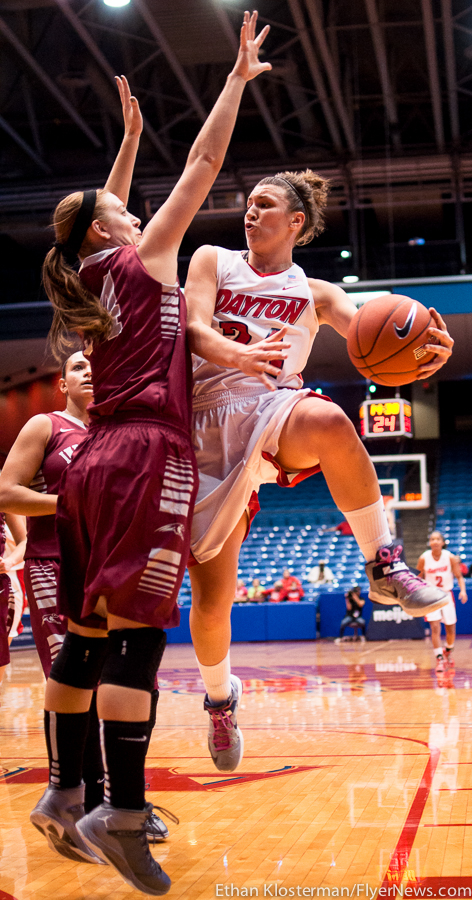Proper changes made to keep excitement in women’s game

University of Dayton junior guard Andrea Hoover (24) passes during an exhibition game against the University of Indianapolis, Friday, Nov. 1, at UD Arena. UD won 84-58. (Ethan Klosterman/Photo Editor)
By: Kyle Janowicz – Staff Writer
The men’s and women’s NCAA basketball rules committees have made key changes that are going to have great effect on the play of each sport.
Women’s basketball is getting a defensive restricted area underneath the basket and, finally, a restricted time in the backcourt. The men’s committee implemented a new defensive positioning rule. Both committees also have introduced replay reviews and restrictions on elbow contact. The NCAA believes that by enforcing these rules they will allow “more offensive freedom,” a faster pace, and a lack of flagrant fouls to college basketball.
The defensive restricted area being placed in the women’s game is actually much like the men’s. In fact, I believe this rule along, with the others, is being placed into the women’s game in order to create a commonality between the two games.
The restricted area rule says a defender may only draw a charge outside the key and under the basket when the offensive player starts with the ball outside of that area. However, if the offensive player is within the key, then the defender may draw a charge within the area.
The second significant rule being added to the game is the backcourt rule. For the first time, a player will not be allowed to hold possession in the backcourt for more than 10 seconds.
I think this rule is perhaps the most important, because it will force players to move the ball up the floor rather than waste an unnecessary amount of time. The new backcourt rule should also increase the tempo of the game, making it more exciting.
If there is one thing that separates men’s and women’s basketball, it is the tempo. Along with the NCAA, I believe that bringing more speed on the women’s side, can help break down the barriers and differences between the sport’s style of play based on gender.
One thing that may be uncontrollable is the amount of jumping and being airborne, which is constantly showing up in the men’s game.
In fact, men will have more freedom to be airborne, as a new rule stating that defenders cannot move into the path of an offensive player who is in mid-air was made this season. This was also probably created to help limit many injuries that can occur due to mid-air collisions.
In addition to these separate rules, the men’s and women’s rule committees are both placing restrictions against elbow contact above the shoulders and adding replay reviews for the last two minutes of regulation and overtime.
While elbow contact may seem okay, it is good that the NCAA is doing something about elbows, specifically around player’s faces. These plays have caused questions about making the right call and preventing players from injuring one another.
By adding replay reviews, officials will be able to correct bad decisions or make better ones near the conclusion of games, which will help reassure the proper outcome of each contest.
Overall, I cannot say that I am disappointed or unhappy with these changes. The NCAA is looking to help the evolution of college basketball without deterring from the beloved sport of the game. These rules should help keep the game safe, fair and bring similarity to both sides regardless of gender.

